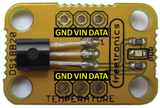By now the Internet of Things has become a ubiquitous term in the technology media - and for good reason. The ability to connect almost anything and everything together for control or data-recording and analysis purposes gives the end user greater convenience and intelligence with the data. To get started with your own IoT experiements may seem outside the scope of the individual - but with the power of Arduino this is certainly more than possible.
By using an online platform to receive, collate and display data and an Ethernet-enabled Arduino-compatible board you can easily work with remotely-captured data, and this has been demonstrated by Gregory Fenton who shows how to capture temperature data with DS18B20 sensors and send it to the online service Xively via the Internet.

Gergory's example is a simple and positive example of how to get started with the technology, from which point you can move forward and modify or expand it for your own means. To get started, visit the project page. And for more, we're on twitter and Google+, so follow us for news and product updates as well.
To get started with your own temperature analysis projects, consider using our TEMP: DS18B20-based temperature sensor module:

... or our HUMID: Humidity and Temperature sensor module based on the popular DHT22 sensor unit. Both modules are fully documented and easy to get started with. These are only two of over a dozen of our sensor and outputs modules.










